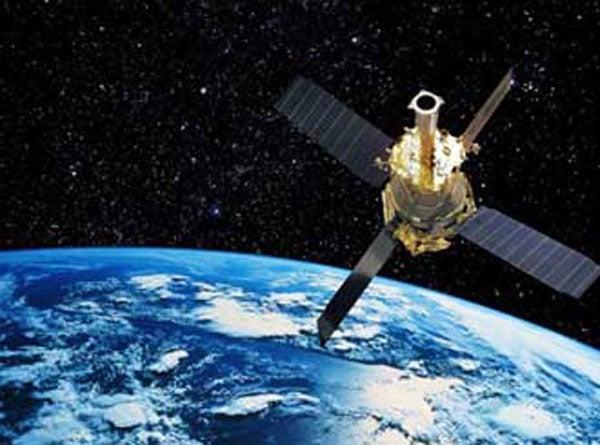The experiment, launched in 2004, used four ultra-precise gyroscopes to measure the hypothesized geodetic effect — the warping of space and time around a gravitational body — and frame-dragging — the amount a spinning object pulls space and time with it as it rotates.
GP-B determined both effects with unprecedented precision by pointing at a single star, IM Pegasi, while in a polar orbit around Earth. If gravity did not affect space and time, GP-B’s gyroscopes would point in the same direction forever while in orbit. But in confirmation of Einstein’s theories, the gyroscopes experienced measurable, minute changes in the direction of their spin while Earth’s gravity pulled at them.
“Imagine the Earth as if it were immersed in honey. As the planet rotates, the honey around it would swirl, and it’s the same with space and time,” said Francis Everitt from Stanford University in Menlo Park, California. “GP-B confirmed two of the most profound predictions of Einstein’s universe, having far-reaching implications across astrophysics research. Likewise, the decades of technological innovation behind the mission will have a lasting legacy on Earth and in space.”
GP-B is one of the longest-running projects in NASA history, with agency involvement starting in the fall of 1963 with initial funding to develop a relativity gyroscope experiment. Subsequent decades of development led to groundbreaking technologies to control environmental disturbances on spacecraft, such as aerodynamic drag, magnetic fields, and thermal variations. The mission’s star tracker and gyroscopes were the most precise ever designed and produced.
GP-B completed its data collection operations and was decommissioned in December 2010.
“The mission results will have a long-term impact on the work of theoretical physicists,” said Bill Danchi from NASA Headquarters in Washington, D.C. “Every future challenge to Einstein’s theories of general relativity will have to seek more precise measurements than the remarkable work GP-B accomplished.”
Innovations enabled by GP-B have been used in GPS technologies that allow airplanes to land unaided. Additional GP-B technologies were applied to NASA’s Cosmic Background Explorer mission, which accurately determined the universe’s background radiation. That measurement is the underpinning of the Big Bang theory and led to the Nobel Prize for NASA physicist John Mather.
The drag-free satellite concept pioneered by GP-B made a number of Earth-observing satellites possible, including NASA’s Gravity Recovery and Climate Experiment and the European Space Agency’s Gravity field and steady-state Ocean Circulation Explorer. These satellites provide the most precise measurements of the shape of Earth, critical for precise navigation on land and sea, and understanding the relationship between ocean circulation and climate patterns.
The experiment, launched in 2004, used four ultra-precise gyroscopes to measure the hypothesized geodetic effect — the warping of space and time around a gravitational body — and frame-dragging — the amount a spinning object pulls space and time with it as it rotates.
GP-B determined both effects with unprecedented precision by pointing at a single star, IM Pegasi, while in a polar orbit around Earth. If gravity did not affect space and time, GP-B’s gyroscopes would point in the same direction forever while in orbit. But in confirmation of Einstein’s theories, the gyroscopes experienced measurable, minute changes in the direction of their spin while Earth’s gravity pulled at them.
“Imagine the Earth as if it were immersed in honey. As the planet rotates, the honey around it would swirl, and it’s the same with space and time,” said Francis Everitt from Stanford University in Menlo Park, California. “GP-B confirmed two of the most profound predictions of Einstein’s universe, having far-reaching implications across astrophysics research. Likewise, the decades of technological innovation behind the mission will have a lasting legacy on Earth and in space.”
GP-B is one of the longest-running projects in NASA history, with agency involvement starting in the fall of 1963 with initial funding to develop a relativity gyroscope experiment. Subsequent decades of development led to groundbreaking technologies to control environmental disturbances on spacecraft, such as aerodynamic drag, magnetic fields, and thermal variations. The mission’s star tracker and gyroscopes were the most precise ever designed and produced.
GP-B completed its data collection operations and was decommissioned in December 2010.
“The mission results will have a long-term impact on the work of theoretical physicists,” said Bill Danchi from NASA Headquarters in Washington, D.C. “Every future challenge to Einstein’s theories of general relativity will have to seek more precise measurements than the remarkable work GP-B accomplished.”
Innovations enabled by GP-B have been used in GPS technologies that allow airplanes to land unaided. Additional GP-B technologies were applied to NASA’s Cosmic Background Explorer mission, which accurately determined the universe’s background radiation. That measurement is the underpinning of the Big Bang theory and led to the Nobel Prize for NASA physicist John Mather.
The drag-free satellite concept pioneered by GP-B made a number of Earth-observing satellites possible, including NASA’s Gravity Recovery and Climate Experiment and the European Space Agency’s Gravity field and steady-state Ocean Circulation Explorer. These satellites provide the most precise measurements of the shape of Earth, critical for precise navigation on land and sea, and understanding the relationship between ocean circulation and climate patterns.










